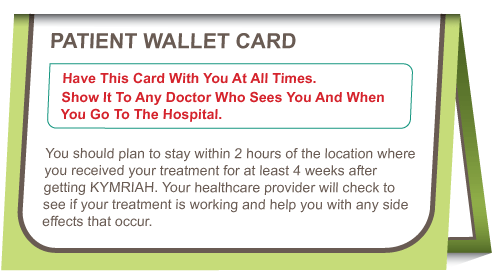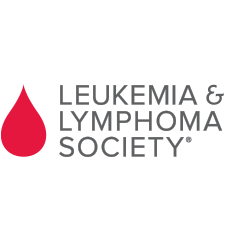Download helpful materials to support you throughout KYMRIAH therapy.
Understanding Side Effects
KYMRIAH
What side effects may I experience with KYMRIAH?
KYMRIAH® (tisagenlecleucel) may cause side effects that are severe or life-threatening. Your treatment team is specially trained to monitor for and manage these potential side effects in people with relapsed/refractory (r/r) diffuse large B-cell lymphoma (DLBCL). Most side effects happen in the weeks following infusion with KYMRIAH.
Get help immediately if you experience any of the following:
- Difficulty breathing
- Fever (100.4°F/38°C or higher)
- Chills/shaking chills
- Confusion
- Severe nausea, vomiting, diarrhea
- Severe muscle or joint pain
- Very low blood pressure
- Dizziness/lightheadedness
- Headache
Cytokine Release Syndrome
Cytokine release syndrome (CRS) may occur when your immune system becomes highly active. It is the most common and expected side effect of KYMRIAH, as well as other CAR-T therapies. Symptoms range from fever or low blood pressure to irregular or rapid heartbeat. CRS may be associated with liver, kidney, and heart dysfunction and bleeding disorders.
Most patients in the clinical trial experienced CRS, usually within 10 days after infusion (median time to first event: 3 days [range: 1-51 days]). Your treatment team will check your progress after infusion. Members of your team are trained to recognize the symptoms of CRS and have specific medicines to treat it.
Neurological Events
KYMRIAH may also have effects on the central nervous system, making you feel confused, agitated, dizzy, or disoriented. More severe symptoms might affect your speech or consciousness or cause seizures. Be sure to tell your treatment team right away if you experience any neurological symptoms. Most neurological events went away on their own in the clinical trials.
Prolonged Low Blood Cell Counts (Cytopenia)
KYMRIAH may cause a condition called cytopenia. This is when you have low levels of one or more types of blood cells. Your treatment team will do blood tests to check all your blood cell counts after treatment with KYMRIAH. Cytopenia that lasts a long time (prolonged) may increase your risk of infection. Cytopenia will be monitored, and your treatment team is prepared to manage it. Tell your doctor right away if you get a fever, are feeling tired, weak, or short of breath, or have unusual bruising or bleeding.
Low Antibody Levels (Hypogammaglobulinemia)
Because KYMRIAH CAR-T cells are designed to detect and destroy your B cells, they will also attack the normal B cells in your body. B cells defend your body by producing antibodies. Antibodies bind to invaders so other immune cells can destroy them.
After KYMRIAH, you may have fewer normal B cells and, therefore, fewer antibodies. A low level of antibodies in your blood is a condition called hypogammaglobulinemia (HY-po-GAMmuh-GLOB-u-lin-EEM-ee-uh). If untreated, a low antibody level may increase your risk for infections. Your treatment team can manage this with antibody replacement medications (for example, intravenous immunoglobulin infusions, also known as IVIG infusions). Hypogammaglobulinemia can last for a long time, so regular IVIG infusions may be needed. Tell your doctor right away if you develop signs or symptoms of an infection.
Effects on Ability to Drive and Use Machines
Do not drive, operate heavy machinery, or do other dangerous things for 8 weeks after you get KYMRIAH because the treatment can cause temporary memory and coordination problems, including sleepiness, confusion, weakness, dizziness, and seizures.
Common side effects
The most common side effects of KYMRIAH are:
- Difficulty breathing
- Fever (100.4°F/38°C or higher)
- Chills/shaking chills
- Confusion
- Severe nausea, vomiting, diarrhea
- Severe muscle or joint pain
- Very low blood pressure
- Dizziness/lightheadedness
- Headache
Please note that these are not all the possible side effects of KYMRIAH treatment. Talk to your treatment team about other possible side effects and how to manage them. You are encouraged to report negative side effects of prescription drugs to the FDA. Visit www.fda.gov/medwatch, or call 1-800-FDA-1088 for more information or to submit a report.

KYMRIAH CAREGIVERS
You can help after infusion by watching for side effects. KYMRIAH can be given in an inpatient (stay in the center) or outpatient (leave center after infusion) setting. Before leaving the treatment center, your treatment team will give you a list of potential side effects to watch for, as well as instructions for what to do if they happen.
KYMRIAH is only available at select treatment centers. These centers have been specially certified in how to manage the risks of cytokine release syndrome and neurological toxicities.
This is why it will be necessary to stay close to your treatment center for at least 4 weeks after receiving KYMRIAH.
What is the KYMRIAH REMS program?
A risk evaluation and mitigation strategy (REMS) is a program to manage known or potential serious risks associated with a drug product and is required by the FDA to ensure that the benefits of the drug outweigh its risks. Because of the risk of cytokine release syndrome and neurological toxicities, the FDA has required a REMS for KYMRIAH. KYMRIAH is only available through select treatment centers participating in the KYMRIAH REMS program.
The KYMRIAH REMS program patient wallet card
As part of the KYMRIAH REMS program, you will be given a wallet card either before or at the time of receiving a KYMRIAH infusion. Be sure to carry your completed wallet card with you at all times.

Visit www.KYMRIAH-REMS.com to learn more about the program or to download a replacement card if needed.



